Analyzing Social and Cultural Issues in Australian Society: Report
VerifiedAdded on 2023/03/23
|10
|2597
|20
Report
AI Summary
This report delves into the social and cultural fabric of Australian society, exploring the influence of institutions like education, religion, health, and employment. It identifies their functions and impacts on individuals, families, and communities. The report highlights social exclusion as a significant issue, focusing on groups like women, Aboriginal and Torres Strait Islander peoples, and people with disabilities, analyzing factors contributing to their inequality and the consequences of this exclusion. It examines the role of government policies in addressing these disparities. The report underscores the existence of social classes within Australia and the impact of societal perceptions on marginalized groups, offering a comprehensive overview of the challenges and complexities within Australian society.
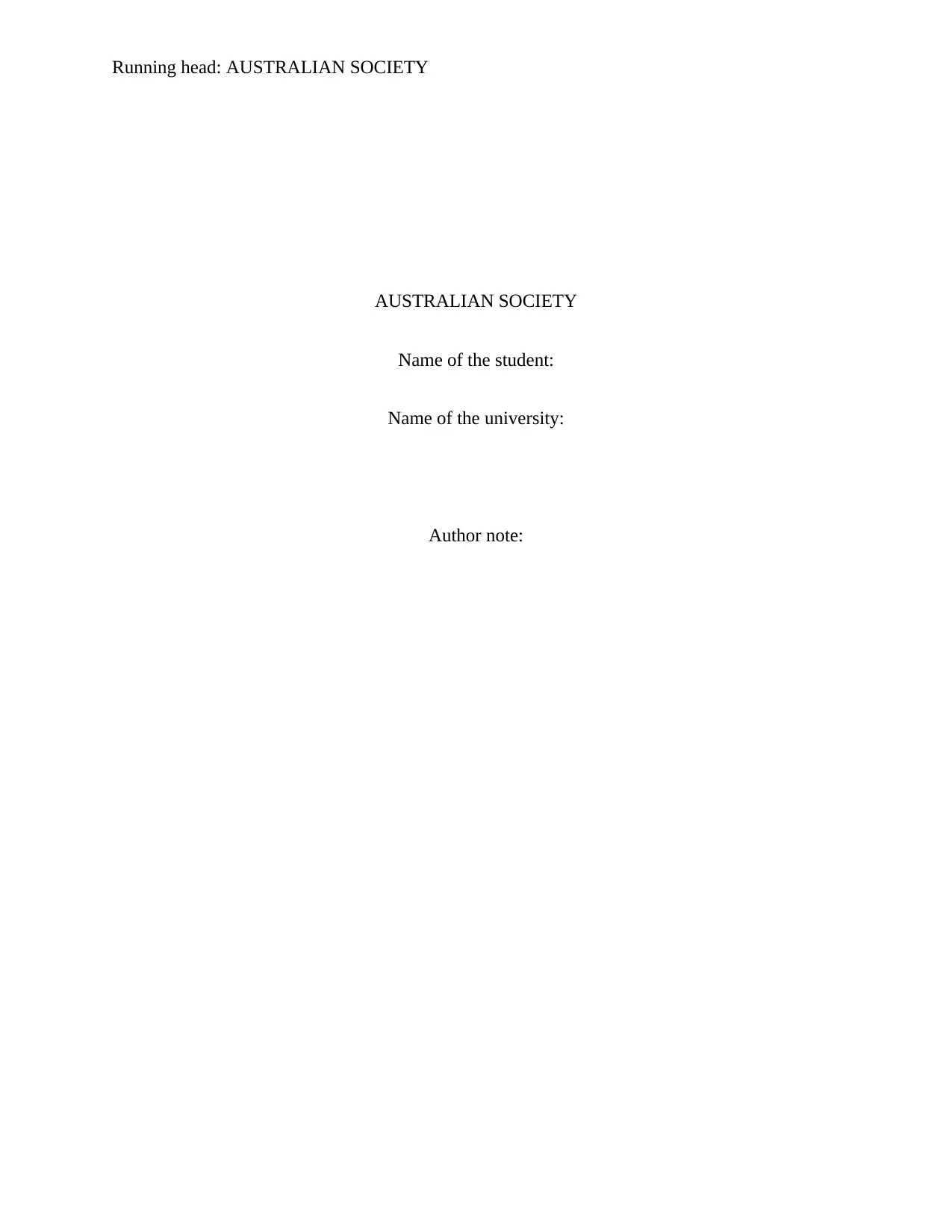
Running head: AUSTRALIAN SOCIETY
AUSTRALIAN SOCIETY
Name of the student:
Name of the university:
Author note:
AUSTRALIAN SOCIETY
Name of the student:
Name of the university:
Author note:
Paraphrase This Document
Need a fresh take? Get an instant paraphrase of this document with our AI Paraphraser
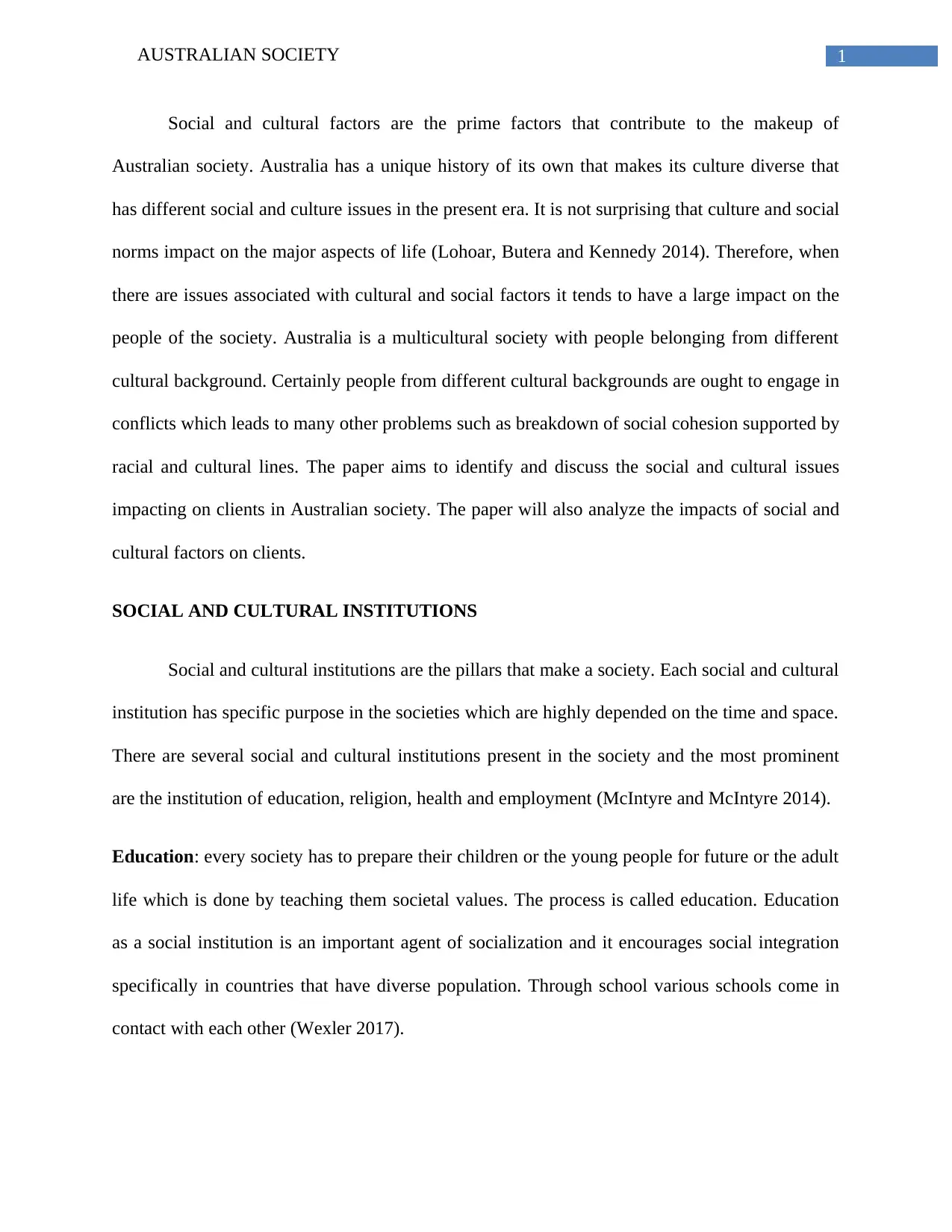
1AUSTRALIAN SOCIETY
Social and cultural factors are the prime factors that contribute to the makeup of
Australian society. Australia has a unique history of its own that makes its culture diverse that
has different social and culture issues in the present era. It is not surprising that culture and social
norms impact on the major aspects of life (Lohoar, Butera and Kennedy 2014). Therefore, when
there are issues associated with cultural and social factors it tends to have a large impact on the
people of the society. Australia is a multicultural society with people belonging from different
cultural background. Certainly people from different cultural backgrounds are ought to engage in
conflicts which leads to many other problems such as breakdown of social cohesion supported by
racial and cultural lines. The paper aims to identify and discuss the social and cultural issues
impacting on clients in Australian society. The paper will also analyze the impacts of social and
cultural factors on clients.
SOCIAL AND CULTURAL INSTITUTIONS
Social and cultural institutions are the pillars that make a society. Each social and cultural
institution has specific purpose in the societies which are highly depended on the time and space.
There are several social and cultural institutions present in the society and the most prominent
are the institution of education, religion, health and employment (McIntyre and McIntyre 2014).
Education: every society has to prepare their children or the young people for future or the adult
life which is done by teaching them societal values. The process is called education. Education
as a social institution is an important agent of socialization and it encourages social integration
specifically in countries that have diverse population. Through school various schools come in
contact with each other (Wexler 2017).
Social and cultural factors are the prime factors that contribute to the makeup of
Australian society. Australia has a unique history of its own that makes its culture diverse that
has different social and culture issues in the present era. It is not surprising that culture and social
norms impact on the major aspects of life (Lohoar, Butera and Kennedy 2014). Therefore, when
there are issues associated with cultural and social factors it tends to have a large impact on the
people of the society. Australia is a multicultural society with people belonging from different
cultural background. Certainly people from different cultural backgrounds are ought to engage in
conflicts which leads to many other problems such as breakdown of social cohesion supported by
racial and cultural lines. The paper aims to identify and discuss the social and cultural issues
impacting on clients in Australian society. The paper will also analyze the impacts of social and
cultural factors on clients.
SOCIAL AND CULTURAL INSTITUTIONS
Social and cultural institutions are the pillars that make a society. Each social and cultural
institution has specific purpose in the societies which are highly depended on the time and space.
There are several social and cultural institutions present in the society and the most prominent
are the institution of education, religion, health and employment (McIntyre and McIntyre 2014).
Education: every society has to prepare their children or the young people for future or the adult
life which is done by teaching them societal values. The process is called education. Education
as a social institution is an important agent of socialization and it encourages social integration
specifically in countries that have diverse population. Through school various schools come in
contact with each other (Wexler 2017).
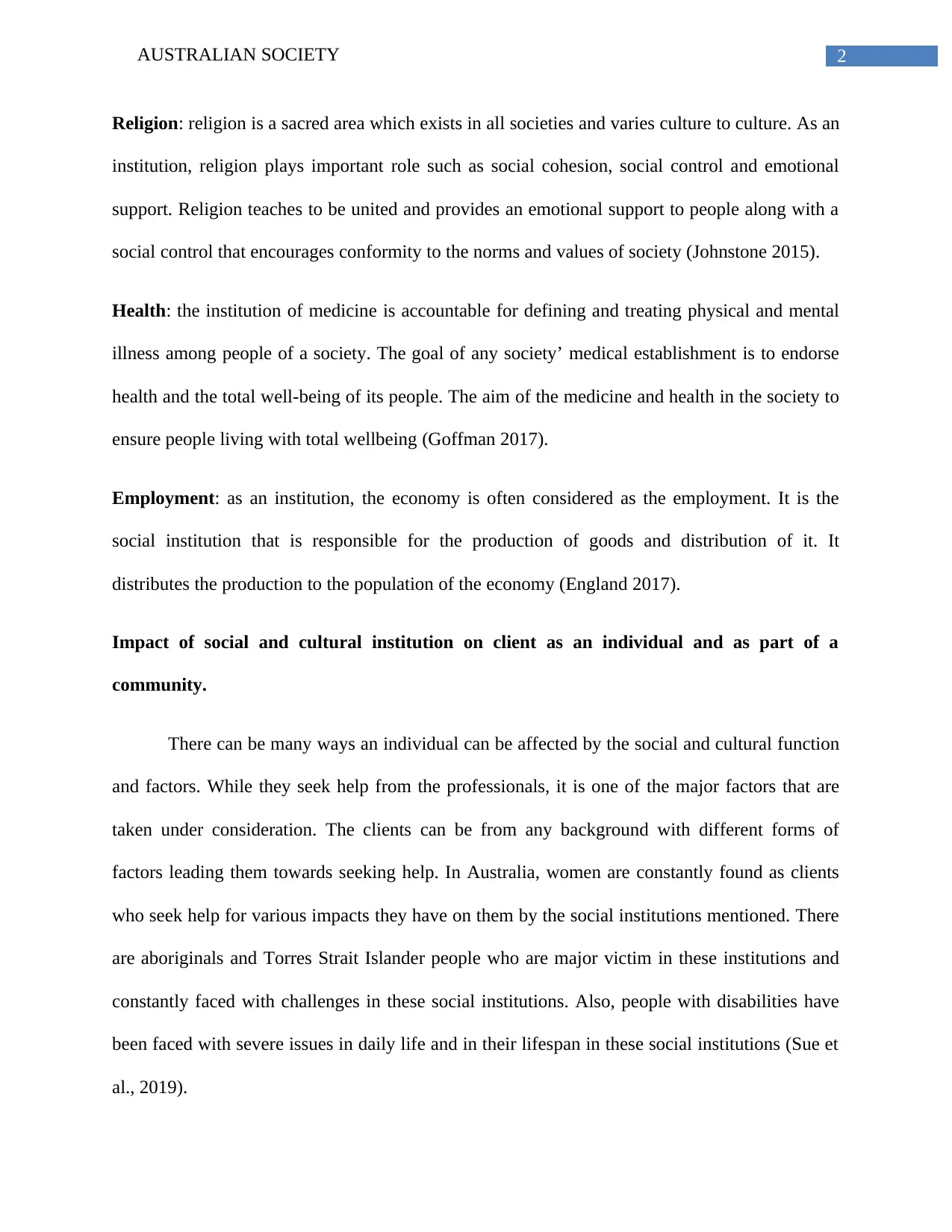
2AUSTRALIAN SOCIETY
Religion: religion is a sacred area which exists in all societies and varies culture to culture. As an
institution, religion plays important role such as social cohesion, social control and emotional
support. Religion teaches to be united and provides an emotional support to people along with a
social control that encourages conformity to the norms and values of society (Johnstone 2015).
Health: the institution of medicine is accountable for defining and treating physical and mental
illness among people of a society. The goal of any society’ medical establishment is to endorse
health and the total well-being of its people. The aim of the medicine and health in the society to
ensure people living with total wellbeing (Goffman 2017).
Employment: as an institution, the economy is often considered as the employment. It is the
social institution that is responsible for the production of goods and distribution of it. It
distributes the production to the population of the economy (England 2017).
Impact of social and cultural institution on client as an individual and as part of a
community.
There can be many ways an individual can be affected by the social and cultural function
and factors. While they seek help from the professionals, it is one of the major factors that are
taken under consideration. The clients can be from any background with different forms of
factors leading them towards seeking help. In Australia, women are constantly found as clients
who seek help for various impacts they have on them by the social institutions mentioned. There
are aboriginals and Torres Strait Islander people who are major victim in these institutions and
constantly faced with challenges in these social institutions. Also, people with disabilities have
been faced with severe issues in daily life and in their lifespan in these social institutions (Sue et
al., 2019).
Religion: religion is a sacred area which exists in all societies and varies culture to culture. As an
institution, religion plays important role such as social cohesion, social control and emotional
support. Religion teaches to be united and provides an emotional support to people along with a
social control that encourages conformity to the norms and values of society (Johnstone 2015).
Health: the institution of medicine is accountable for defining and treating physical and mental
illness among people of a society. The goal of any society’ medical establishment is to endorse
health and the total well-being of its people. The aim of the medicine and health in the society to
ensure people living with total wellbeing (Goffman 2017).
Employment: as an institution, the economy is often considered as the employment. It is the
social institution that is responsible for the production of goods and distribution of it. It
distributes the production to the population of the economy (England 2017).
Impact of social and cultural institution on client as an individual and as part of a
community.
There can be many ways an individual can be affected by the social and cultural function
and factors. While they seek help from the professionals, it is one of the major factors that are
taken under consideration. The clients can be from any background with different forms of
factors leading them towards seeking help. In Australia, women are constantly found as clients
who seek help for various impacts they have on them by the social institutions mentioned. There
are aboriginals and Torres Strait Islander people who are major victim in these institutions and
constantly faced with challenges in these social institutions. Also, people with disabilities have
been faced with severe issues in daily life and in their lifespan in these social institutions (Sue et
al., 2019).
⊘ This is a preview!⊘
Do you want full access?
Subscribe today to unlock all pages.

Trusted by 1+ million students worldwide
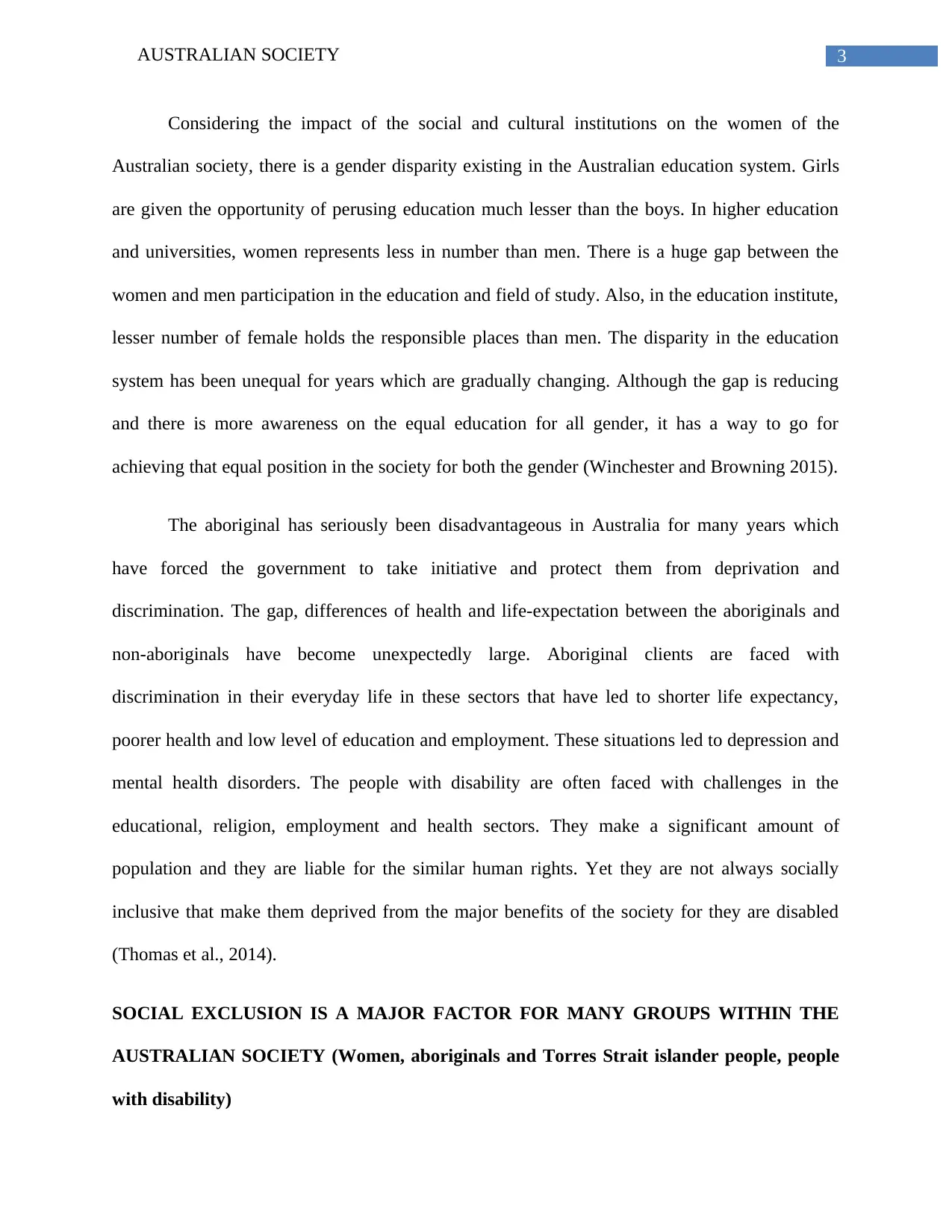
3AUSTRALIAN SOCIETY
Considering the impact of the social and cultural institutions on the women of the
Australian society, there is a gender disparity existing in the Australian education system. Girls
are given the opportunity of perusing education much lesser than the boys. In higher education
and universities, women represents less in number than men. There is a huge gap between the
women and men participation in the education and field of study. Also, in the education institute,
lesser number of female holds the responsible places than men. The disparity in the education
system has been unequal for years which are gradually changing. Although the gap is reducing
and there is more awareness on the equal education for all gender, it has a way to go for
achieving that equal position in the society for both the gender (Winchester and Browning 2015).
The aboriginal has seriously been disadvantageous in Australia for many years which
have forced the government to take initiative and protect them from deprivation and
discrimination. The gap, differences of health and life-expectation between the aboriginals and
non-aboriginals have become unexpectedly large. Aboriginal clients are faced with
discrimination in their everyday life in these sectors that have led to shorter life expectancy,
poorer health and low level of education and employment. These situations led to depression and
mental health disorders. The people with disability are often faced with challenges in the
educational, religion, employment and health sectors. They make a significant amount of
population and they are liable for the similar human rights. Yet they are not always socially
inclusive that make them deprived from the major benefits of the society for they are disabled
(Thomas et al., 2014).
SOCIAL EXCLUSION IS A MAJOR FACTOR FOR MANY GROUPS WITHIN THE
AUSTRALIAN SOCIETY (Women, aboriginals and Torres Strait islander people, people
with disability)
Considering the impact of the social and cultural institutions on the women of the
Australian society, there is a gender disparity existing in the Australian education system. Girls
are given the opportunity of perusing education much lesser than the boys. In higher education
and universities, women represents less in number than men. There is a huge gap between the
women and men participation in the education and field of study. Also, in the education institute,
lesser number of female holds the responsible places than men. The disparity in the education
system has been unequal for years which are gradually changing. Although the gap is reducing
and there is more awareness on the equal education for all gender, it has a way to go for
achieving that equal position in the society for both the gender (Winchester and Browning 2015).
The aboriginal has seriously been disadvantageous in Australia for many years which
have forced the government to take initiative and protect them from deprivation and
discrimination. The gap, differences of health and life-expectation between the aboriginals and
non-aboriginals have become unexpectedly large. Aboriginal clients are faced with
discrimination in their everyday life in these sectors that have led to shorter life expectancy,
poorer health and low level of education and employment. These situations led to depression and
mental health disorders. The people with disability are often faced with challenges in the
educational, religion, employment and health sectors. They make a significant amount of
population and they are liable for the similar human rights. Yet they are not always socially
inclusive that make them deprived from the major benefits of the society for they are disabled
(Thomas et al., 2014).
SOCIAL EXCLUSION IS A MAJOR FACTOR FOR MANY GROUPS WITHIN THE
AUSTRALIAN SOCIETY (Women, aboriginals and Torres Strait islander people, people
with disability)
Paraphrase This Document
Need a fresh take? Get an instant paraphrase of this document with our AI Paraphraser
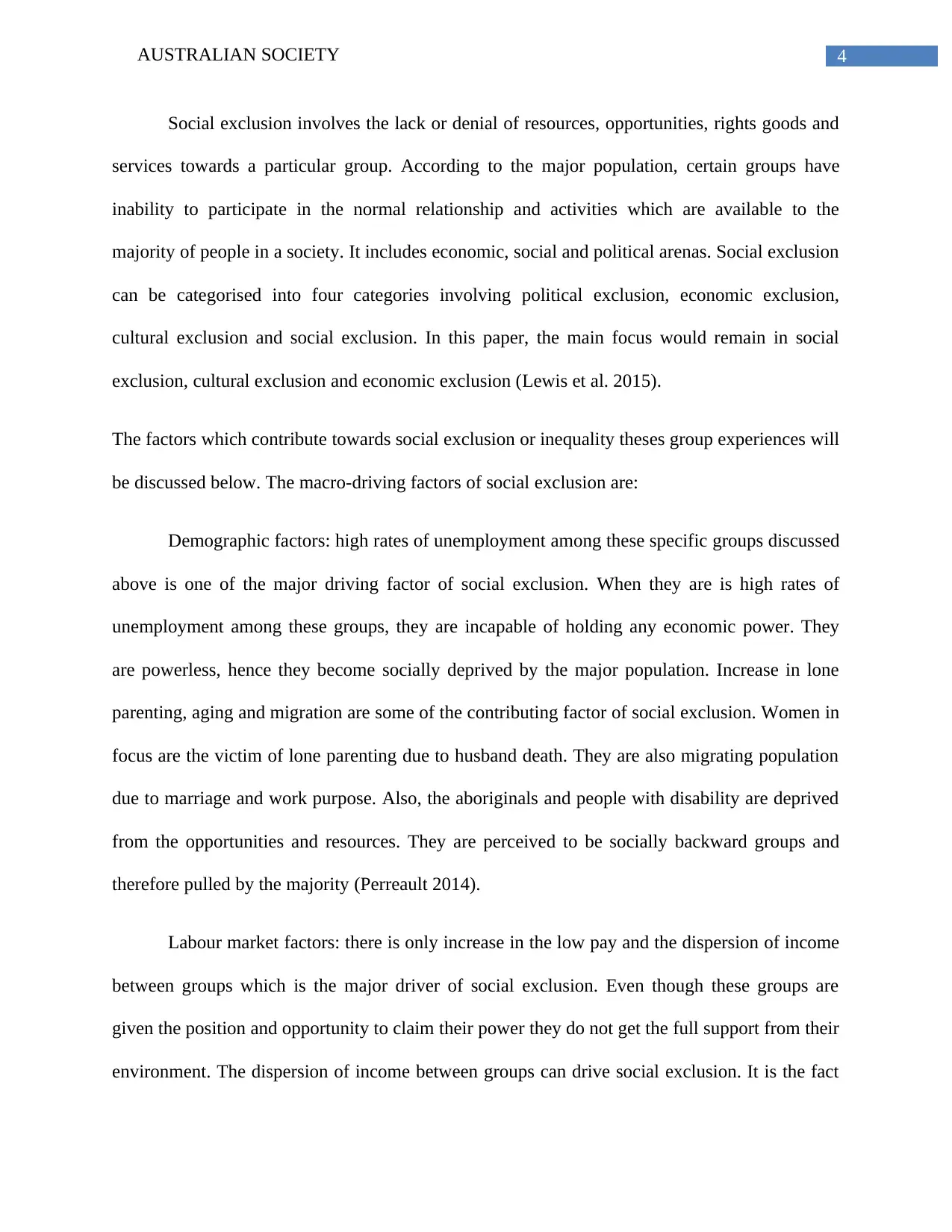
4AUSTRALIAN SOCIETY
Social exclusion involves the lack or denial of resources, opportunities, rights goods and
services towards a particular group. According to the major population, certain groups have
inability to participate in the normal relationship and activities which are available to the
majority of people in a society. It includes economic, social and political arenas. Social exclusion
can be categorised into four categories involving political exclusion, economic exclusion,
cultural exclusion and social exclusion. In this paper, the main focus would remain in social
exclusion, cultural exclusion and economic exclusion (Lewis et al. 2015).
The factors which contribute towards social exclusion or inequality theses group experiences will
be discussed below. The macro-driving factors of social exclusion are:
Demographic factors: high rates of unemployment among these specific groups discussed
above is one of the major driving factor of social exclusion. When they are is high rates of
unemployment among these groups, they are incapable of holding any economic power. They
are powerless, hence they become socially deprived by the major population. Increase in lone
parenting, aging and migration are some of the contributing factor of social exclusion. Women in
focus are the victim of lone parenting due to husband death. They are also migrating population
due to marriage and work purpose. Also, the aboriginals and people with disability are deprived
from the opportunities and resources. They are perceived to be socially backward groups and
therefore pulled by the majority (Perreault 2014).
Labour market factors: there is only increase in the low pay and the dispersion of income
between groups which is the major driver of social exclusion. Even though these groups are
given the position and opportunity to claim their power they do not get the full support from their
environment. The dispersion of income between groups can drive social exclusion. It is the fact
Social exclusion involves the lack or denial of resources, opportunities, rights goods and
services towards a particular group. According to the major population, certain groups have
inability to participate in the normal relationship and activities which are available to the
majority of people in a society. It includes economic, social and political arenas. Social exclusion
can be categorised into four categories involving political exclusion, economic exclusion,
cultural exclusion and social exclusion. In this paper, the main focus would remain in social
exclusion, cultural exclusion and economic exclusion (Lewis et al. 2015).
The factors which contribute towards social exclusion or inequality theses group experiences will
be discussed below. The macro-driving factors of social exclusion are:
Demographic factors: high rates of unemployment among these specific groups discussed
above is one of the major driving factor of social exclusion. When they are is high rates of
unemployment among these groups, they are incapable of holding any economic power. They
are powerless, hence they become socially deprived by the major population. Increase in lone
parenting, aging and migration are some of the contributing factor of social exclusion. Women in
focus are the victim of lone parenting due to husband death. They are also migrating population
due to marriage and work purpose. Also, the aboriginals and people with disability are deprived
from the opportunities and resources. They are perceived to be socially backward groups and
therefore pulled by the majority (Perreault 2014).
Labour market factors: there is only increase in the low pay and the dispersion of income
between groups which is the major driver of social exclusion. Even though these groups are
given the position and opportunity to claim their power they do not get the full support from their
environment. The dispersion of income between groups can drive social exclusion. It is the fact
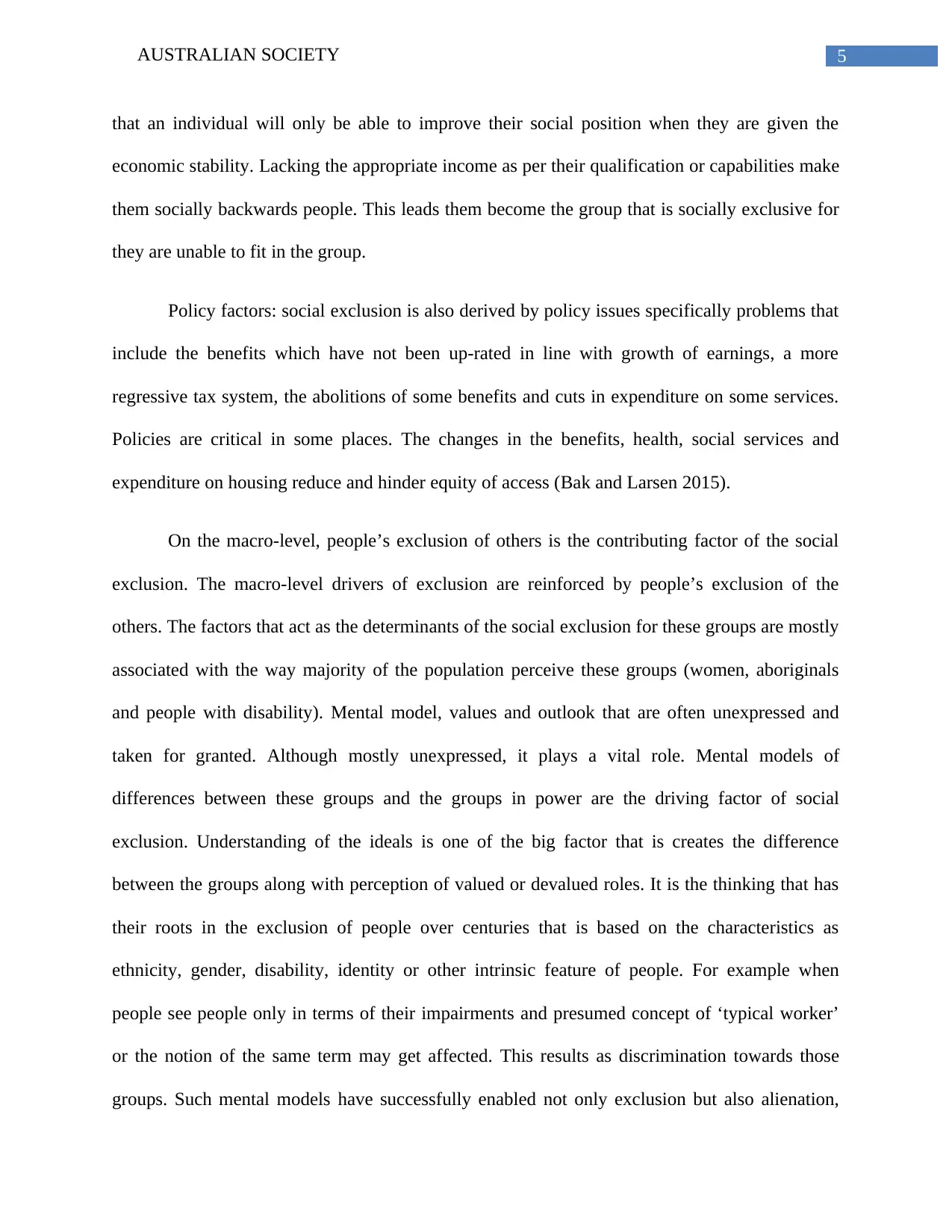
5AUSTRALIAN SOCIETY
that an individual will only be able to improve their social position when they are given the
economic stability. Lacking the appropriate income as per their qualification or capabilities make
them socially backwards people. This leads them become the group that is socially exclusive for
they are unable to fit in the group.
Policy factors: social exclusion is also derived by policy issues specifically problems that
include the benefits which have not been up-rated in line with growth of earnings, a more
regressive tax system, the abolitions of some benefits and cuts in expenditure on some services.
Policies are critical in some places. The changes in the benefits, health, social services and
expenditure on housing reduce and hinder equity of access (Bak and Larsen 2015).
On the macro-level, people’s exclusion of others is the contributing factor of the social
exclusion. The macro-level drivers of exclusion are reinforced by people’s exclusion of the
others. The factors that act as the determinants of the social exclusion for these groups are mostly
associated with the way majority of the population perceive these groups (women, aboriginals
and people with disability). Mental model, values and outlook that are often unexpressed and
taken for granted. Although mostly unexpressed, it plays a vital role. Mental models of
differences between these groups and the groups in power are the driving factor of social
exclusion. Understanding of the ideals is one of the big factor that is creates the difference
between the groups along with perception of valued or devalued roles. It is the thinking that has
their roots in the exclusion of people over centuries that is based on the characteristics as
ethnicity, gender, disability, identity or other intrinsic feature of people. For example when
people see people only in terms of their impairments and presumed concept of ‘typical worker’
or the notion of the same term may get affected. This results as discrimination towards those
groups. Such mental models have successfully enabled not only exclusion but also alienation,
that an individual will only be able to improve their social position when they are given the
economic stability. Lacking the appropriate income as per their qualification or capabilities make
them socially backwards people. This leads them become the group that is socially exclusive for
they are unable to fit in the group.
Policy factors: social exclusion is also derived by policy issues specifically problems that
include the benefits which have not been up-rated in line with growth of earnings, a more
regressive tax system, the abolitions of some benefits and cuts in expenditure on some services.
Policies are critical in some places. The changes in the benefits, health, social services and
expenditure on housing reduce and hinder equity of access (Bak and Larsen 2015).
On the macro-level, people’s exclusion of others is the contributing factor of the social
exclusion. The macro-level drivers of exclusion are reinforced by people’s exclusion of the
others. The factors that act as the determinants of the social exclusion for these groups are mostly
associated with the way majority of the population perceive these groups (women, aboriginals
and people with disability). Mental model, values and outlook that are often unexpressed and
taken for granted. Although mostly unexpressed, it plays a vital role. Mental models of
differences between these groups and the groups in power are the driving factor of social
exclusion. Understanding of the ideals is one of the big factor that is creates the difference
between the groups along with perception of valued or devalued roles. It is the thinking that has
their roots in the exclusion of people over centuries that is based on the characteristics as
ethnicity, gender, disability, identity or other intrinsic feature of people. For example when
people see people only in terms of their impairments and presumed concept of ‘typical worker’
or the notion of the same term may get affected. This results as discrimination towards those
groups. Such mental models have successfully enabled not only exclusion but also alienation,
⊘ This is a preview!⊘
Do you want full access?
Subscribe today to unlock all pages.

Trusted by 1+ million students worldwide
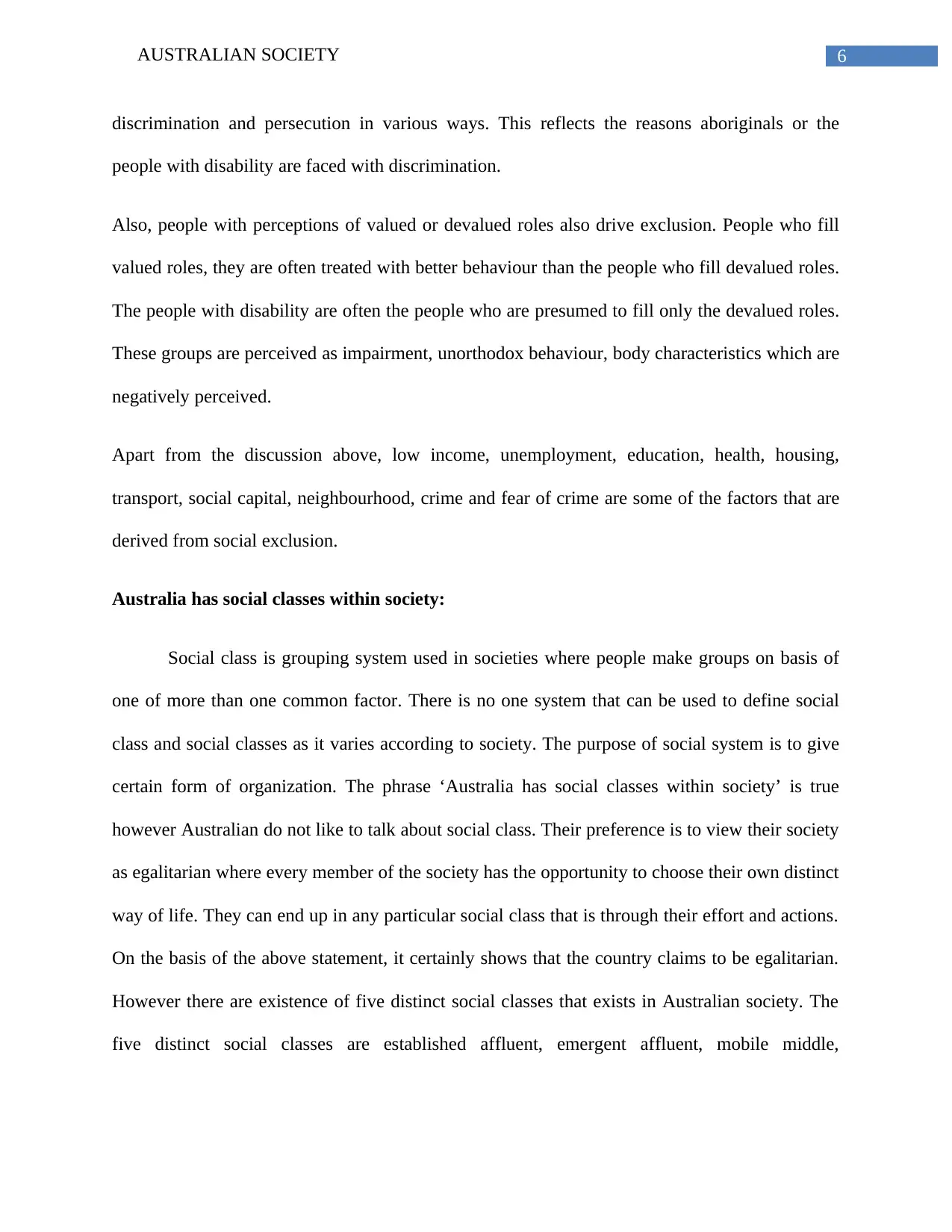
6AUSTRALIAN SOCIETY
discrimination and persecution in various ways. This reflects the reasons aboriginals or the
people with disability are faced with discrimination.
Also, people with perceptions of valued or devalued roles also drive exclusion. People who fill
valued roles, they are often treated with better behaviour than the people who fill devalued roles.
The people with disability are often the people who are presumed to fill only the devalued roles.
These groups are perceived as impairment, unorthodox behaviour, body characteristics which are
negatively perceived.
Apart from the discussion above, low income, unemployment, education, health, housing,
transport, social capital, neighbourhood, crime and fear of crime are some of the factors that are
derived from social exclusion.
Australia has social classes within society:
Social class is grouping system used in societies where people make groups on basis of
one of more than one common factor. There is no one system that can be used to define social
class and social classes as it varies according to society. The purpose of social system is to give
certain form of organization. The phrase ‘Australia has social classes within society’ is true
however Australian do not like to talk about social class. Their preference is to view their society
as egalitarian where every member of the society has the opportunity to choose their own distinct
way of life. They can end up in any particular social class that is through their effort and actions.
On the basis of the above statement, it certainly shows that the country claims to be egalitarian.
However there are existence of five distinct social classes that exists in Australian society. The
five distinct social classes are established affluent, emergent affluent, mobile middle,
discrimination and persecution in various ways. This reflects the reasons aboriginals or the
people with disability are faced with discrimination.
Also, people with perceptions of valued or devalued roles also drive exclusion. People who fill
valued roles, they are often treated with better behaviour than the people who fill devalued roles.
The people with disability are often the people who are presumed to fill only the devalued roles.
These groups are perceived as impairment, unorthodox behaviour, body characteristics which are
negatively perceived.
Apart from the discussion above, low income, unemployment, education, health, housing,
transport, social capital, neighbourhood, crime and fear of crime are some of the factors that are
derived from social exclusion.
Australia has social classes within society:
Social class is grouping system used in societies where people make groups on basis of
one of more than one common factor. There is no one system that can be used to define social
class and social classes as it varies according to society. The purpose of social system is to give
certain form of organization. The phrase ‘Australia has social classes within society’ is true
however Australian do not like to talk about social class. Their preference is to view their society
as egalitarian where every member of the society has the opportunity to choose their own distinct
way of life. They can end up in any particular social class that is through their effort and actions.
On the basis of the above statement, it certainly shows that the country claims to be egalitarian.
However there are existence of five distinct social classes that exists in Australian society. The
five distinct social classes are established affluent, emergent affluent, mobile middle,
Paraphrase This Document
Need a fresh take? Get an instant paraphrase of this document with our AI Paraphraser
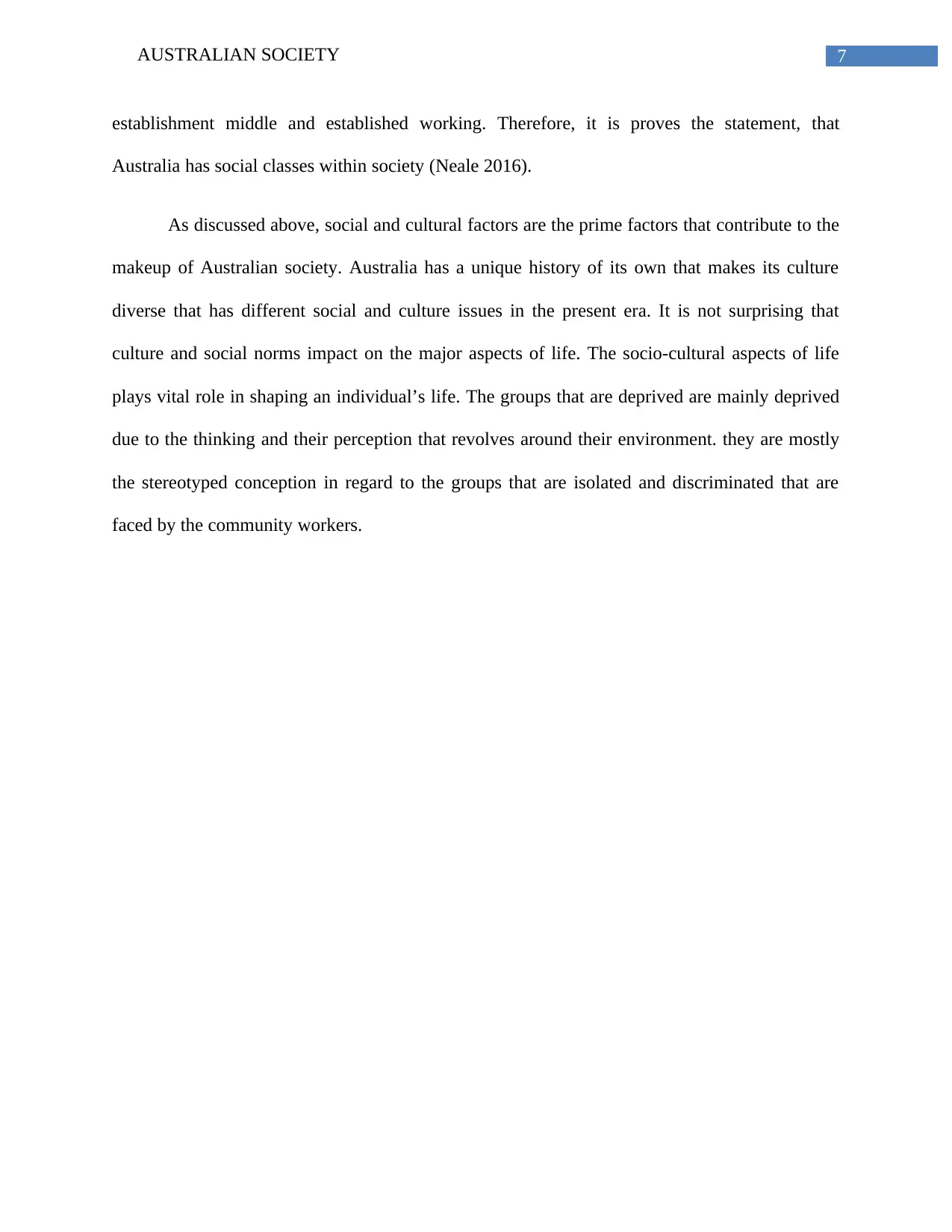
7AUSTRALIAN SOCIETY
establishment middle and established working. Therefore, it is proves the statement, that
Australia has social classes within society (Neale 2016).
As discussed above, social and cultural factors are the prime factors that contribute to the
makeup of Australian society. Australia has a unique history of its own that makes its culture
diverse that has different social and culture issues in the present era. It is not surprising that
culture and social norms impact on the major aspects of life. The socio-cultural aspects of life
plays vital role in shaping an individual’s life. The groups that are deprived are mainly deprived
due to the thinking and their perception that revolves around their environment. they are mostly
the stereotyped conception in regard to the groups that are isolated and discriminated that are
faced by the community workers.
establishment middle and established working. Therefore, it is proves the statement, that
Australia has social classes within society (Neale 2016).
As discussed above, social and cultural factors are the prime factors that contribute to the
makeup of Australian society. Australia has a unique history of its own that makes its culture
diverse that has different social and culture issues in the present era. It is not surprising that
culture and social norms impact on the major aspects of life. The socio-cultural aspects of life
plays vital role in shaping an individual’s life. The groups that are deprived are mainly deprived
due to the thinking and their perception that revolves around their environment. they are mostly
the stereotyped conception in regard to the groups that are isolated and discriminated that are
faced by the community workers.
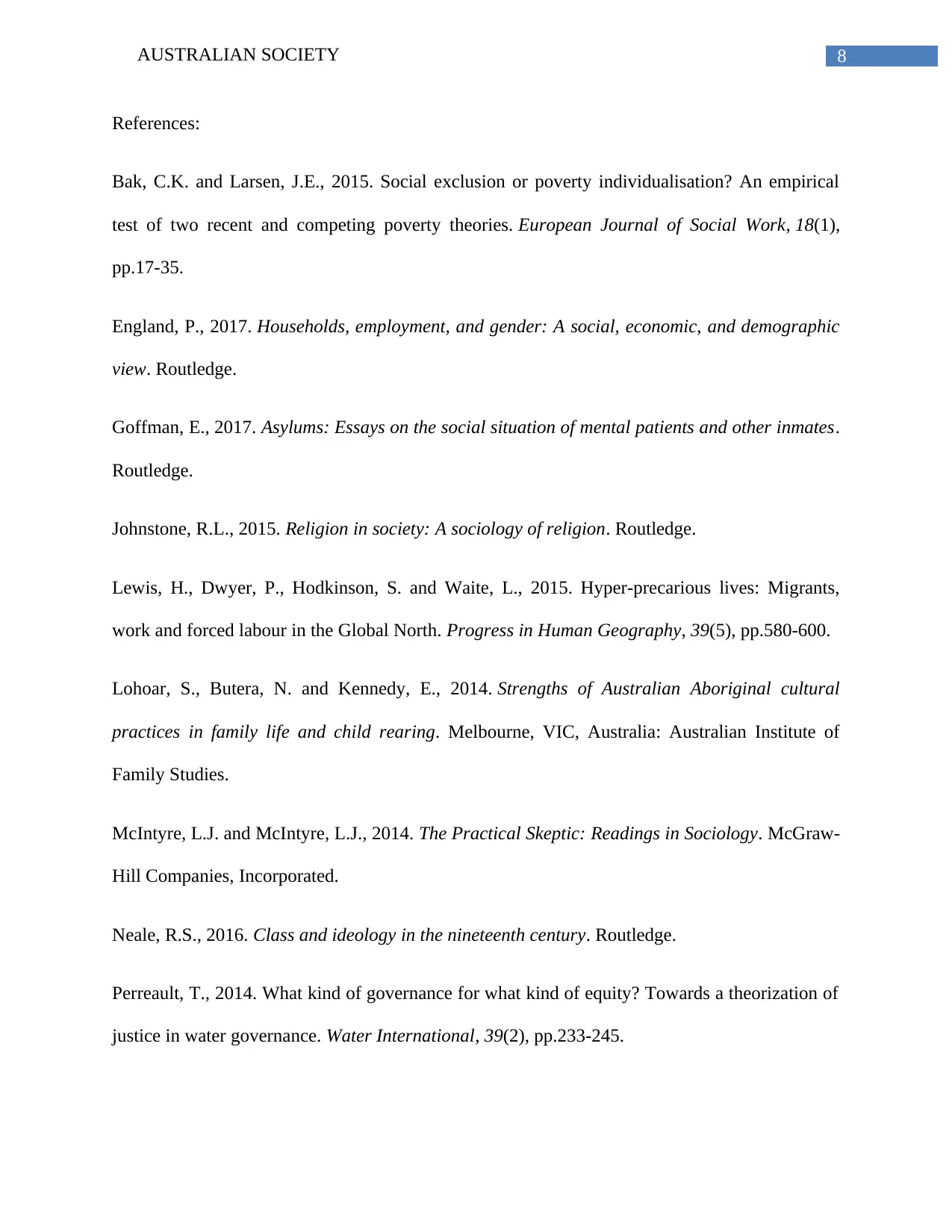
8AUSTRALIAN SOCIETY
References:
Bak, C.K. and Larsen, J.E., 2015. Social exclusion or poverty individualisation? An empirical
test of two recent and competing poverty theories. European Journal of Social Work, 18(1),
pp.17-35.
England, P., 2017. Households, employment, and gender: A social, economic, and demographic
view. Routledge.
Goffman, E., 2017. Asylums: Essays on the social situation of mental patients and other inmates.
Routledge.
Johnstone, R.L., 2015. Religion in society: A sociology of religion. Routledge.
Lewis, H., Dwyer, P., Hodkinson, S. and Waite, L., 2015. Hyper-precarious lives: Migrants,
work and forced labour in the Global North. Progress in Human Geography, 39(5), pp.580-600.
Lohoar, S., Butera, N. and Kennedy, E., 2014. Strengths of Australian Aboriginal cultural
practices in family life and child rearing. Melbourne, VIC, Australia: Australian Institute of
Family Studies.
McIntyre, L.J. and McIntyre, L.J., 2014. The Practical Skeptic: Readings in Sociology. McGraw-
Hill Companies, Incorporated.
Neale, R.S., 2016. Class and ideology in the nineteenth century. Routledge.
Perreault, T., 2014. What kind of governance for what kind of equity? Towards a theorization of
justice in water governance. Water International, 39(2), pp.233-245.
References:
Bak, C.K. and Larsen, J.E., 2015. Social exclusion or poverty individualisation? An empirical
test of two recent and competing poverty theories. European Journal of Social Work, 18(1),
pp.17-35.
England, P., 2017. Households, employment, and gender: A social, economic, and demographic
view. Routledge.
Goffman, E., 2017. Asylums: Essays on the social situation of mental patients and other inmates.
Routledge.
Johnstone, R.L., 2015. Religion in society: A sociology of religion. Routledge.
Lewis, H., Dwyer, P., Hodkinson, S. and Waite, L., 2015. Hyper-precarious lives: Migrants,
work and forced labour in the Global North. Progress in Human Geography, 39(5), pp.580-600.
Lohoar, S., Butera, N. and Kennedy, E., 2014. Strengths of Australian Aboriginal cultural
practices in family life and child rearing. Melbourne, VIC, Australia: Australian Institute of
Family Studies.
McIntyre, L.J. and McIntyre, L.J., 2014. The Practical Skeptic: Readings in Sociology. McGraw-
Hill Companies, Incorporated.
Neale, R.S., 2016. Class and ideology in the nineteenth century. Routledge.
Perreault, T., 2014. What kind of governance for what kind of equity? Towards a theorization of
justice in water governance. Water International, 39(2), pp.233-245.
⊘ This is a preview!⊘
Do you want full access?
Subscribe today to unlock all pages.

Trusted by 1+ million students worldwide
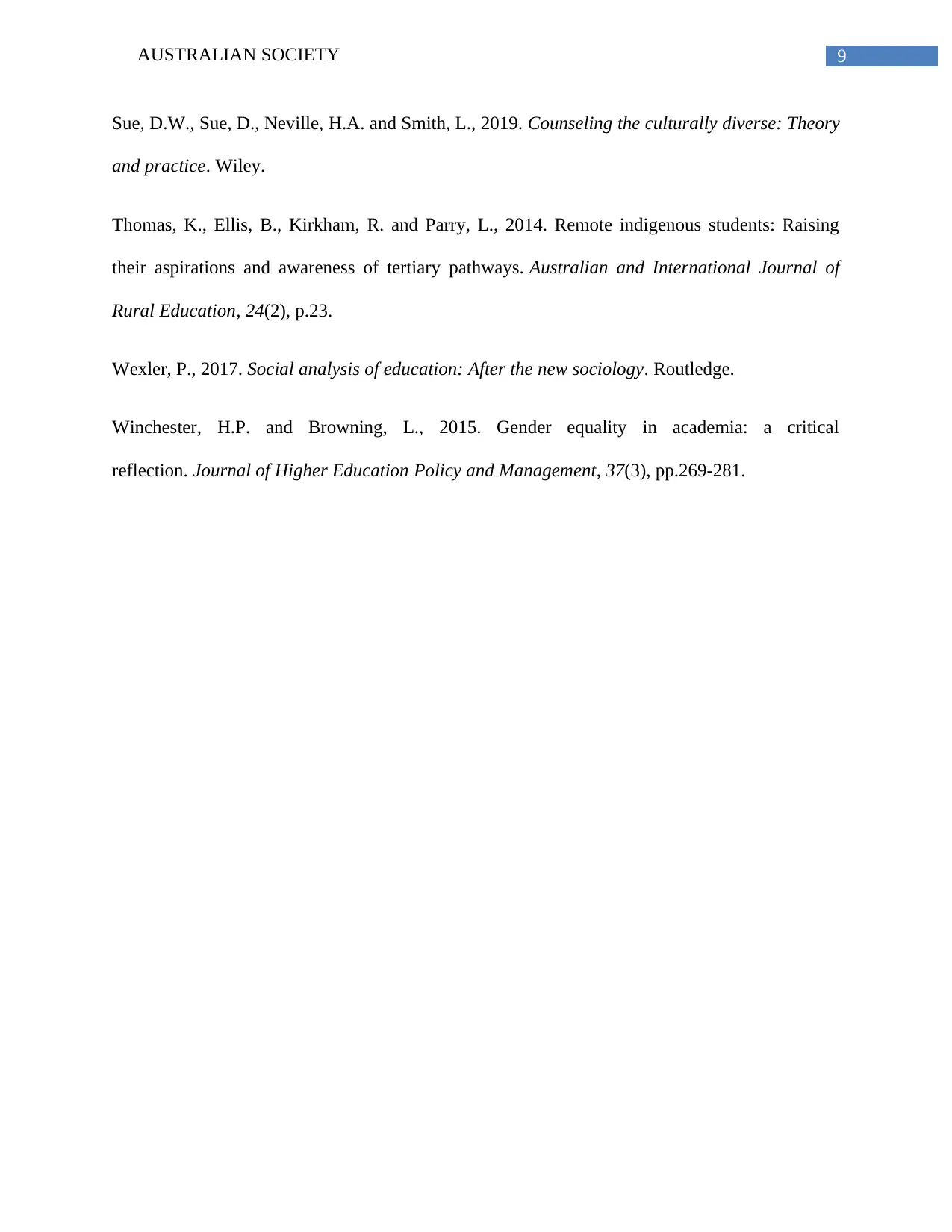
9AUSTRALIAN SOCIETY
Sue, D.W., Sue, D., Neville, H.A. and Smith, L., 2019. Counseling the culturally diverse: Theory
and practice. Wiley.
Thomas, K., Ellis, B., Kirkham, R. and Parry, L., 2014. Remote indigenous students: Raising
their aspirations and awareness of tertiary pathways. Australian and International Journal of
Rural Education, 24(2), p.23.
Wexler, P., 2017. Social analysis of education: After the new sociology. Routledge.
Winchester, H.P. and Browning, L., 2015. Gender equality in academia: a critical
reflection. Journal of Higher Education Policy and Management, 37(3), pp.269-281.
Sue, D.W., Sue, D., Neville, H.A. and Smith, L., 2019. Counseling the culturally diverse: Theory
and practice. Wiley.
Thomas, K., Ellis, B., Kirkham, R. and Parry, L., 2014. Remote indigenous students: Raising
their aspirations and awareness of tertiary pathways. Australian and International Journal of
Rural Education, 24(2), p.23.
Wexler, P., 2017. Social analysis of education: After the new sociology. Routledge.
Winchester, H.P. and Browning, L., 2015. Gender equality in academia: a critical
reflection. Journal of Higher Education Policy and Management, 37(3), pp.269-281.
1 out of 10
Related Documents
Your All-in-One AI-Powered Toolkit for Academic Success.
+13062052269
info@desklib.com
Available 24*7 on WhatsApp / Email
![[object Object]](/_next/static/media/star-bottom.7253800d.svg)
Unlock your academic potential
Copyright © 2020–2025 A2Z Services. All Rights Reserved. Developed and managed by ZUCOL.





